|
 MAKING
YOUR OWN PET FIRST AID KIT - EZ and important MAKING
YOUR OWN PET FIRST AID KIT - EZ and important
 IS YOUR POOCH A GENIUS?- Simple tests to find out IS YOUR POOCH A GENIUS?- Simple tests to find out
 PET EMERGENCIES ON THE
ROAD
- 24-hour and after-hours
veterinary facilities PET EMERGENCIES ON THE
ROAD
- 24-hour and after-hours
veterinary facilities
 FELINE HEARTWORMS - A hidden and deadly
threat FELINE HEARTWORMS - A hidden and deadly
threat
 MOCKING BIRDS MIMIC - But do they have
their own voice? MOCKING BIRDS MIMIC - But do they have
their own voice?
 YEAR OF THE RAT - Consultant
for Ratatouille says rodent misunderstood. YEAR OF THE RAT - Consultant
for Ratatouille says rodent misunderstood.
 BARKER BARKING ABOUT SPAY/NEUTER
LEGISLATION - Bob Barker is back! BARKER BARKING ABOUT SPAY/NEUTER
LEGISLATION - Bob Barker is back!
Also in this issue:
 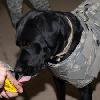 Shelley
Morrison was the fiesty
maid Rosario on Will & Grace. In real life she's a
major animal advocate. "Whatever cache we have as celebrities
must be used to shine light, educate and give back,"
she tells Animal
Radio® Shelley
Morrison was the fiesty
maid Rosario on Will & Grace. In real life she's a
major animal advocate. "Whatever cache we have as celebrities
must be used to shine light, educate and give back,"
she tells Animal
Radio®
Dean - The Combat Therapy
Dog. Dean was deployed
to Baghdad to serve as a therapy dog to the soldiers. Animal Radio® connects
live to Iraq and the 64th Brigade Support Battalion. |
|
Green
Dogs for St. Patrick's Day? Don't Do It!
 St.
Patrick's Day honors St. Patrick, the patron saint of Ireland.
We celebrate St. Patrick's Day on March 17, even though March
17 was not the day St. Patrick was born but the day he died.
We don't know the exact date of his birth, but most scholars
believe the year was 385 AD and the year of his death was 461
AD. St. Patrick is believed to have driven the snakes from Ireland. St.
Patrick's Day honors St. Patrick, the patron saint of Ireland.
We celebrate St. Patrick's Day on March 17, even though March
17 was not the day St. Patrick was born but the day he died.
We don't know the exact date of his birth, but most scholars
believe the year was 385 AD and the year of his death was 461
AD. St. Patrick is believed to have driven the snakes from Ireland.
Americans march in parades,
dance the Irish jig and gather to sing Irish songs. People wear
green in memory of Ireland, the Emerald Isle and wear shamrocks,
which are clovers with three leaves. All things seem to be green,
from green beer to green dogs.
But wait, while eating and
drinking things are a personal choice, our dogs don't chose fto
begreen. While they may look cute and some may even seem to enjoy
the attention, it can actually be bad for their health.
The ASPC "Animal Poison
Control Center" views on dyeing your pet green for St. Patrick's
Day is clear. Don't do it. When asked "If, under any circumstances,
is it safe to dye your pet green for St. Patrick's Day?"
Dr. Hansen, a veterinary toxicologist and senior vice president
of ASPC's Animal Poison Control Center, replied, "When dyeing
animal fur, there is always a chance that animals may not tolerate
odors or residues left by these products. Further, they may not
react favorably to the change in response that humans will exhibit
when they encounter strangely colored pets, or they could have
allergic reactions or eye irritation depending on the product
formulation."
So go ahead and indulge in
all of that green fair, but please leave Fido the color he was
born to be!
This weekend on Animal Radio®
Shelley Morrison, Will
& Grace
 Shelley is an animal lover and
involved with many animal charities. But what you might not guess
is that Shelley Morrison has had a remarkable and fascinating
forty-plus year career in show business, from co-starring in
feature films with the likes of Hollywood legends Gregory Peck,
William Holden and Anthony Quinn, to co-starring on one of television's
most acclaimed situation comedies. Or that this talented woman
of Hispanic descent, born and raised in The Bronx in New York
City, whose first language was Spanish and whose parents were
Spanish Jews, has embraced the spiritual tradition of the Lakota
Sioux. But Shelley Morrison is better known as Rosario, the feisty
maid on NBC's hit comedy series "Will and Grace." Shelley is an animal lover and
involved with many animal charities. But what you might not guess
is that Shelley Morrison has had a remarkable and fascinating
forty-plus year career in show business, from co-starring in
feature films with the likes of Hollywood legends Gregory Peck,
William Holden and Anthony Quinn, to co-starring on one of television's
most acclaimed situation comedies. Or that this talented woman
of Hispanic descent, born and raised in The Bronx in New York
City, whose first language was Spanish and whose parents were
Spanish Jews, has embraced the spiritual tradition of the Lakota
Sioux. But Shelley Morrison is better known as Rosario, the feisty
maid on NBC's hit comedy series "Will and Grace."
Morrison has also become tirelessly
involved in charities close to her heart. The first, A.N.G.E.L.S
Day (Animals Needing Generous Endowments of Love & Support),
is an organization dedicated to help senior citizens take care
of their pets in times of crisis such as during hospitalization.
"One woman broke her foot and was unable to walk her dog,"
Morrison explains, "and we had a volunteer come every day
for a year to be sure that the dog was taken care of." L.A.
Shanti is another organization that Morrison has dedicated time
and resources to; it was the first organization in Los Angeles
founded to help those with HIV and AIDS, offering support, prevention
advice and volunteer training for the last two decades. Morrison,
who has survived two bouts with cancer, has also raised money
for the American Cancer Society and this year led the "Sea
of Pink" Survivors' Ceremony to kick off the Ninth Annual
Susan G. Komen "Race for the Cure" in Los Angeles.
Shelley is one of the special
hosts of the Farm Sanctuary's Anniversary Gala, which will be
a glamorous evening of entertainment and education, bringing
together celebrity supporters, key legislators and animal advocates
in honor of farm animals and those leading the movement to protect
them from abuse.
http://www.shelleymorrison.com
 Hear Shelley Morrison on Animal Radio® Hear Shelley Morrison on Animal Radio®
Combat
Therapy Dog
Capt. Phillip Rittermeyer
- Pfc. April Campbell
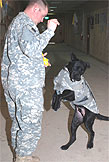 Hearing a noise in the hallway,
the long-nosed creature gets out of his bed on the floor and
trots to the door as he searches the cool February air for a
clue. Hearing a noise in the hallway,
the long-nosed creature gets out of his bed on the floor and
trots to the door as he searches the cool February air for a
clue.
Once he confirms the presence
of friendly forces, Dean cocks his long face around to see if
his companion wants to go visit the Soldiers in the hallway as
much as he does. With all four limbs on the ground, Dean will
certainly need the chaplain's help to open the door.
Dean is a three-year-old black-Labrador
mix and serves as a therapy dog. He deployed to Camp Taji with
the Soldiers of the 64th Brigade Support Battalion, 3rd Brigade
Combat Team, 4th Infantry Division, Multi-National Division Baghdad.
Capt. Phillip Rittermeyer,
a Kansas City, Mo., native, who serves as the battalion chaplain
for the 64th BSB, adopted him from a shelter one month prior
to the unit's deployment.
Rittermeyer, who works with
and cares for the dog, brought Dean with him to Iraq on orders
to provide comfort and boost the morale of the Mountaineer Soldiers
during their day-to-day activities as they operate in the northern
outreaches of Baghdad province.
"I worked with a dog previously
in civilian ministry," Rittermeyer said. "They help
comfort people as well as lower stress and blood pressure."
Capt. Christi Moreno, a San
Antonio native, who serves as the brigade mental health officer
with 3rd BCT, also sees the benefit animals such as Dean provide
to Soldiers in an environment with increased stress.
"Animals are very therapeutic,"
she said. "They show unconditional love and they're not
judgmental."
When Rittermeyer must attend
a meeting or preside over church services, other Mountaineer
Soldiers, such as Sgt. Tasha Jackson, a Colorado Springs, Colo.,
native, who serves as a supply sergeant with Headquarters and
Headquarters Company, 64th BSB, spend time taking care of and
getting to know Dean. Caring for 'man's best friend' is nothing
new to this dog lover.
 "Dean
reminds me of my very first dog, Raider, who I had from the time
I was in second grade until a few years after high school,"
said Jackson. "Dean
reminds me of my very first dog, Raider, who I had from the time
I was in second grade until a few years after high school,"
said Jackson.
The loving canine helps her
overcome some of the difficult times during her deployment.
"If I'm having a down
day and the chaplain brings Dean over for me to watch,"
she said, "it usually helps to cheer me up."
Between teaching the playful
four-legged creature how to dance and trying not to let the dog
walk her when he needs to be taken out, Dean provides her with
comfort, which reminds her of home, she added.
Dean stays connected with the
Soldiers by communicating his own needs or wants as well.
"If I'm working, he'll put his head on my lap so I'll pay
attention to him," she said.
"(Animals) bring the best
out of people," said Moreno. "People tend to have an
inherent connection with them."
As their deployment continues,
Dean will continue his morale support operations with the Mountaineer
Soldiers, often bringing smiles and an eager hand to pet his
black and white fur wherever he goes.
 Hear Capt. Phillip Rittermeyer on Animal
Radio® Hear Capt. Phillip Rittermeyer on Animal
Radio®
| Hear
breaking news as it happens - Animal Radio®
is streaming online 24/7 Listen LIVE Now! |
|
Fred Willard, Back To You
  Fred
Willard is an actor, comedian, writer and animal lover. He recently
hosted the Canine Film Festival in San Francisco with Jane Lynch,
to present the film "Best in Show, " where his improvisational
performance as dog show commentator Buck Laughlin earned him
the adulation of critics and an American Comedy Award for funniest
performance by a supporting actor in a feature film. Fred
Willard is an actor, comedian, writer and animal lover. He recently
hosted the Canine Film Festival in San Francisco with Jane Lynch,
to present the film "Best in Show, " where his improvisational
performance as dog show commentator Buck Laughlin earned him
the adulation of critics and an American Comedy Award for funniest
performance by a supporting actor in a feature film.
Fred and his wife live in Los
Angeles where they run a weekly sketch comedy workshop. While
Fred currently does not have any pets, he has been feeding homeless
cats for the last 8 years, even though he is allergic to them.
Look for Fred as Marsh McGinley
in the new television comedy Back to You also starring Kelsey
Grammer (Frasier) and Patricia Heaton (Everybody Loves Raymond).
http://www.fredwillard.com
 Hear Fred Willard on Animal Radio® Hear Fred Willard on Animal Radio®
Wendie Malick, Just Shoot
Me
 Emmy-nominated actress
Wendie Malick has starred in such television hits as "Just
Shoot Me" and "Jake in Progress," but her most
important role is as a devoted animal advocate in real life. Emmy-nominated actress
Wendie Malick has starred in such television hits as "Just
Shoot Me" and "Jake in Progress," but her most
important role is as a devoted animal advocate in real life.
A vegetarian and self-described
animal lover, Wendie has spoken out against the use of chimpanzees
in Hollywood, written legislators to ban canned hunting, and
appeared in anti-fur television commercials telling consumers
that compassion is the new fashion.
She also served as a presenter
at IDA's 2nd Annual Guardian Awards, as well as a presenter at
the Genesis Awards, which is an annual event to honor outstanding
individuals in the major media for raising awareness of animal
issues presented by The Humane Society of the United States.
Wendie tells Animal Radio®
that she grew up with dogs, and in fact, states her older sister
was a collie!
http://www.arktrust.org
 Hear Wendie Malick on Animal Radio® Hear Wendie Malick on Animal Radio®
Rue McClanahan, The Golden
Girls
 Rue McClanahan is an Emmy Award-winning American
actor, best known for her roles acting alongside Bea Arthur on
the television sitcoms Maude (she played Vivian Harmon) and The
Golden Girls (she played the man-crazed Southern belle Blanche
Devereaux). Rue McClanahan is an Emmy Award-winning American
actor, best known for her roles acting alongside Bea Arthur on
the television sitcoms Maude (she played Vivian Harmon) and The
Golden Girls (she played the man-crazed Southern belle Blanche
Devereaux).
A lifelong animal-rights advocate,
McClanahan was one of the first celebrity supporters of PETA.
Rue doesn't have a preference
of cats or dogs, she loves them both, and currently resides in
New York with her husband and her cat.
Look for her new movie later
this year where she plays Lady Rochford in "The Other Boleyn
Girl," a movie about two sisters contending for the affection
of King Henry VIII.
 Hear Rue McClanahan on Animal Radio® Hear Rue McClanahan on Animal Radio®
Is
Your Pooch a Genius?
Stacy Stubblefield,
PoochIQ.com
 You can find out if your pooch
is a genius with 15 simple exercises designed to entertain and
challenge your pet. The Pooch IQ Kit is a first-of-its-kind tool
that lets you accurately test your pooch's intelligence level
while having loads of fun with your pup! You can find out if your pooch
is a genius with 15 simple exercises designed to entertain and
challenge your pet. The Pooch IQ Kit is a first-of-its-kind tool
that lets you accurately test your pooch's intelligence level
while having loads of fun with your pup!
Think you know everything about
your dog's personality? Think again! Almost everyone we know
who's given their pup the Pooch IQ Test has been shocked by their
dog's reaction to at least one (and usually more) of the exercises.
After the test is done, you'll not only be able to calculate
your pup's IQ score, but you'll also understand your dog and
his or her behaviors on a much deeper level.
 Inside the Pooch IQ Kit, you'll find
a booklet with 15 mentally stimulating exercises for your dog
and a scoring key you'll use to calculate your pup's IQ. Plus,
the IQ Kit includes all the toys and props you'll need to do
the exercises with your pet. Inside the Pooch IQ Kit, you'll find
a booklet with 15 mentally stimulating exercises for your dog
and a scoring key you'll use to calculate your pup's IQ. Plus,
the IQ Kit includes all the toys and props you'll need to do
the exercises with your pet.
The IQ Kit contains 15 thought-provoking
exercises that test skills like:
* Learning from Experience
* Short-Term Memory
* Persistence
* Ability to See Similarities
* Problem-Solving Skills
* Ability to Recognize Patterns
* Many more!
And remember, a low score on
the IQ test isn't an indicator of the quality of your dog. As
long as you have a pooch that makes you happy, his/her intelligence
shouldn't really matter. Plus, super-smart dogs tend to be a
lot more mischievous than their peers, so be happy you don't
have a pooch who can outsmart you!
http://www.poochiq.com
 Hear Stacy Stubblefield on Animal Radio® Hear Stacy Stubblefield on Animal Radio®
2008 Year of the Rat
Debbie Ducommun,
"The Rat Lady"
 With
2008 being Year of the Rat in the Chinese calendar, rats are
being celebrated for the unique qualities that make them excellent
companion animals. And who knows better how to celebrate a rat
than Debbie Ducommun "The Rat Lady!" With
2008 being Year of the Rat in the Chinese calendar, rats are
being celebrated for the unique qualities that make them excellent
companion animals. And who knows better how to celebrate a rat
than Debbie Ducommun "The Rat Lady!"
Debbie Ducommun, known as "The
Rat Lady," is internationally recognized as an expert on
domestic rats. She has worked in the animal care industry for
over 18 years and has a background in animal training, nutrition,
and animal health care. She is the founder of The Rat Fan Club
and writes, edits, and publishes The Rat Report. Ducommun has
promoted rats on television and radio including appearances on
The Tonight Show with Jay Leno, The Howie Mandel Show, To Tell
The Truth and Ripley's Believe It Or Not. And, she was a technical
consultant on the Pixar movie Ratatouille!
Listen in as Debbie speaks
with a caller who wants to know if rats get lonely when left
alone for long periods of time? Do you know the answer?
http://www.ratfanclub.org
 Hear Debbie Ducommun on Animal Radio® Hear Debbie Ducommun on Animal Radio®
Pet
Emergencies on the Road
Cindy Halley, Pet
E. R. Guide
 While
this book was intended for the RV lifestyle, everyone who travels
with a pet can benefit. And, if you travel with a pet, what do
you do if something happens to your pet along the way? A sudden
illness or a run in with wild life can put them at risk. Where
do you turn when you are away from home on the road? While
this book was intended for the RV lifestyle, everyone who travels
with a pet can benefit. And, if you travel with a pet, what do
you do if something happens to your pet along the way? A sudden
illness or a run in with wild life can put them at risk. Where
do you turn when you are away from home on the road?
This guide is a must have for
anyone who travels with a pet. It is a directory of 24-hour and
after-hours veterinary facilities throughout the United States.
It will direct you to the nearest facility closest to you so
you don't waste precious time trying to find a veterinarian in
cities you are not familiar with.
While you hope you never need
it - you can't afford to be without it!
http://www.tldirectory.com
 Hear Cindy Halley on Animal
Radio® Hear Cindy Halley on Animal
Radio®
Pet Kit
 Take some time out and create
your own doggy or kitty first aid kit. If they could thank you,
they would. Take some time out and create
your own doggy or kitty first aid kit. If they could thank you,
they would.
Chances are, your family knows
exactly which cabinet to turn to at the sight of a runny nose,
a splinter, blood, or tummy ache. But when your cat or dog is
in need of more than a scratch behind the ears, are you ready?
Proper preparation is the best tool to arm yourself with in case
of a pet emergency. A pet first aid kit is a smart, personalized,
easily created resource that will prepare you to think quickly
and logically. Here, The Animal Medical Center in New York shows
what should be readily available now to aid in quick thinking
for the future.
It's all in the bag
It's a good idea to put everything related to your pet's health
issues in one, easily accessible bag. A clear, plastic tote is
a smart option; you can place emergency numbers on the inside
facing out for quick retrieval, and the flexible bag makes storage
easier than a rigid box.
Reaching out
The most vital emergencies are the ones where you'll need outside
assistance. Make sure that essential emergency numbers are the
easiest to find. If you don't already have an emergency card
number, write the following on an index card:
- Animal Poison Control Contact
Info
- Your pet's regular veterinarian
- Local Veterinary Emergency
Animal Hospital Info
- Emergency Pet Taxis (for urban
areas many taxis don't allow animals)
- Pet's health records in case
your vet is not available
The Prep Work
You may be able to lessen the impact of an emergency by simply
being well prepared. Start by buying a book on pets the knowledge
you'll gain from this information may help when you really need
it. Pay special attention to the list of substances commonly
found in your home which are toxic to your pet. Keeping a "thumbs
down" list handy will allow swift action in case of accidental
ingestion. Secondly, travelers should make a copy of their pet's
medical records that stay with the animal at all times, in case
the vet or sitter isn't as familiar with your pet as your family.
Additionally, a blanket or large towel can be a lifesaver for
a cold pet, a transporter for a large dog, or a bandage for an
injured or bleeding leg.
Dr. Mom
Many minor injuries can be self-treated with proper knowledge
and equipment.
- Tweezers: For splinter or
foreign object removal
Nail trimmer: Ask your local pet supply store for the style of
trimmer right for your pet.
- Scissors: Handy for hair clumps
and foreign object tangles
- Betadine Sponges: For cleaning
of cuts and wounds, to be used with an antibacterial cleanser
- Sterile Vaseline for eyes:
If you're bathing your pet, this will prevent soap and water
from getting in their eyes
- Saline Solution: Regular human
contact lens saline solution can be used with a to flush out
dirt, sand, or other irritant - just squeeze the contents directly
into the eye.
- Peroxide: To only be used
to induce vomiting when Animal Poison Control says to do so.
You should call Animal Poison Control when your dog or cat has
consumed something from the "no" list. Not to be used
for cleaning wounds.
- Triple antibiotic ointment:
To place directly on a cut
- Sterile telpha pads (no stick):
Sticky bandages and fur don't mix. Wrap the wound with the pads
before placing on the bandage
- Bandages
Remember, proper, immediate
first-aid is only the first step in the treatment of a pet injury
or emergency. While your intervention may prevent serious harm,
you must always seek veterinary care as soon as possible to assure
the best outcome for your companion.
http://www.amcny.org
How Pets Can Reduce Our
Stress and Anxieties
By: Stanley Popovich
 Animals and our pets can be a
great way to reduce our every day stresses and anxieties. It
is not easy to deal with our fears and anxieties, however, spending
time with animals can makes us feel better. Here is a list of
ways of how animals can help us to better cope with our fears,
anxieties, and stresses. Animals and our pets can be a
great way to reduce our every day stresses and anxieties. It
is not easy to deal with our fears and anxieties, however, spending
time with animals can makes us feel better. Here is a list of
ways of how animals can help us to better cope with our fears,
anxieties, and stresses.
Spending time with animals can be a great source of companionship.
Whether you have a pet or go to your local shelter, spending
time with an animal or pet can help us to feel better. Also many
people talk to their pets and this can help us to get their problems
out in the open. Animals can be of good company to all of us
and can prevent the fear of being alone during our troubles.
Helping animals and other people through community service can
be a great way to overcome our anxieties. There are many animals
out there who could benefit from your time and talents. Doing
something that will help your pet or other animals can give you
a source of pride and accomplishment and also can lead to possible
friendships with others.
Sitting around and accomplishing nothing will not make things
any better whether its dealing with the fear of being alone or
something else. Animals can help us to be active and to focus
our energies on working with them instead of worrying about things
that may or may not happen. This will prevent us from worrying
about our current situation.
One of the ways to manage stress is to challenge your negative
thinking with positive thoughts. Animals can help us to relax
and help us to focus on the good things in our lives. This will
help us to focus positively on any situation. Playing with animals
can help reduce our fears and anxieties in any situation.
Animals can get our minds off of our problems. A person could
do an activity with their pet or other animals that will give
them a fresh perspective on things. Spending time with animals
will get your mind off of the problem and give you the energy
to do other things. Most importantly, playing with animals will
give you the self-confidence that you can cope and that you can
get through the day.
Remember that there are many ways that animals can reduce the
stresses of our every day life, however, they are not a substitute
of getting professional help. If your fears and anxieties become
overwhelming, then you will need to talk to a counselor. The
next time you feel stressed, spend some time with your pet or
other animals and you will be better able to cope with your worries.
Stan Popovich is the
author of "A Layman's Guide to Managing Fear Using Psychology,
Christianity and Non Resistant Methods" - an easy to read
book that presents a general overview of techniques that are
effective in managing persistent fears and anxieties. For additional
information go to: http://www.managingfear.com
|
|
Coming Up on Animal Radio®:
Bob Barker
 Even
though Bob Barker retired from the Price is Right, he is definitely
not retired! Bob has kept himself busy by helping the animals.
He was involved in the removal of two elephants, Ruby from the
Los Angeles Zoo and Maggie from the Anchorage, Alaska Zoo, to
the Performing Animal Welfare Society (PAWS) in Northern California,
where the habitat is more suitable for elephants. Even
though Bob Barker retired from the Price is Right, he is definitely
not retired! Bob has kept himself busy by helping the animals.
He was involved in the removal of two elephants, Ruby from the
Los Angeles Zoo and Maggie from the Anchorage, Alaska Zoo, to
the Performing Animal Welfare Society (PAWS) in Northern California,
where the habitat is more suitable for elephants.
As you will recall, Bob always
mentioned at the end of every Price is Right Show to "Spay
or Neuter Your Pet." Now, Bob has been directly involved
with the enactment of a Spay-Neuter Ordinance by the City of
Los Angeles, which was signed by the Mayor the morning of February
26; as well as with AB 1634 which has been passed by the California
Assembly and is to be considered by the State Senate shortly.
We also just got word that House Bill 1185 is up for a vote by
the Colorado State Assembly, the development of which was influenced
by Bob's efforts on behalf of spay-neuter legislation in California.
Find out what we can we expect
next from Bob - this weekend on Animal Radio®
Over Your Head (HGTV) with
Eric Stromer
 Eric Stromer is the host of Over
Your Head, a series that focuses on how homeowners deal with
the aftermath of a renovation project gone bad. That's when Stromer's
team comes to save the day. Eric Stromer is the host of Over
Your Head, a series that focuses on how homeowners deal with
the aftermath of a renovation project gone bad. That's when Stromer's
team comes to save the day.
Eric has remodeled homes for Mel Gibson, Dylan McDermott, Elijah
Woods and Jasmine Guy as well as Sally and Erv Stromer (his own
mom and dad!).
Eric tells Animal
Radio® about his show and how one guardian
contacted him after his "dog ate his yard." His Cocker
spaniel evidently chewed up the drip system, dug up the plants
and used the new flower beds as bed cushions. Eric came to the
rescue and the dog has a new yard (which hopefully he won't destroy!).
Is A Skunk Your Next Pet
or Do You Currently Own One?
 If you are thinking of acquiring
one of these animals as a pet, educate yourself and your family
members on raising and living with a skunk. Animal Radio® discovers
that skunks have unique personalities, health and dietary considerations.
A baby skunk is not a puppy or a kitten, but an intelligent animal
with its own set of natural actions and strange reactions! If you are thinking of acquiring
one of these animals as a pet, educate yourself and your family
members on raising and living with a skunk. Animal Radio® discovers
that skunks have unique personalities, health and dietary considerations.
A baby skunk is not a puppy or a kitten, but an intelligent animal
with its own set of natural actions and strange reactions!
|
|
| ANIMAL
RADIO® PRODUCT REVIEW for
March |
|
    (rated 4 out of 5 paws) (rated 4 out of 5 paws)
 Doggy
Java Doggy
Java
You share so much with
you dog, why not share your morning cup of coffee? Because, regular
coffee is not good for our animals (and while we are on the subject
is it really good for us?). Anyway, now your dog can have
his own version of morning coffee.
And, it is not just flavored
water (and not a coffee product) but it also contains vitamins
specially formulated for your pooch. It comes in a powdered form
and all you have to add is water.
Here is one more activity your
dog can join in on. It also comes in a great kit perfect for
gift-giving! And don't worry if your cat tries a cup, it will
not harm him.
http://www.doggyjava.com
See other reviews at AnimalRadio.com.
Send products for review on-air and in this newsletter to: Animal
Radio Network™ Product Reviews, 233 East 330 North, Kanab,
Utah 84741. Product may not be returned. Allow 5 weeks for review.
|
Animal Minute on
Animal
Radio®
with Britt Savage |
Monkeys Are As Smart As College
Students
 It's pretty common knowledge that some
college students have more than studying on their minds. But
even with all of that monkeying around, you'd think that students
at Duke University would be smarter than a monkey. It's pretty common knowledge that some
college students have more than studying on their minds. But
even with all of that monkeying around, you'd think that students
at Duke University would be smarter than a monkey.
A recent study at Duke pitted
two female monkeys against fourteen college students. Both were
asked to solve math problems. They were shown two sets of dots
on flashcards, which they had to mentally add. The humans were
not allowed to count or verbalize as they worked. Surprisingly,
the monkeys did about as well as the college students.
The research pointed to the
importance of language in helping humans solve more advanced
calculations. Both teams were paid for the efforts. The college
students received $10, and the monkeys, they got their favorite
drink Kool-Aid.
Miracle Dog Lab Survives
With Arrow in His Body
 When
the Cornelisse family adopted Remington, a 2-year-old Chocolate
Labrador Retriever, little did they know he had an arrow stuck
in his chest. When
the Cornelisse family adopted Remington, a 2-year-old Chocolate
Labrador Retriever, little did they know he had an arrow stuck
in his chest.
The Cornelisse family had Remington
for about 6 months when they noticed he wasn't acting like his
normal self. He wasn't interested in playing, nor did he seem
to even want to move.
When Scott Cornelisse picked
Remington up, he felt a lump in his chest, which he thought might
be a broken rib. X-rays later showed that the lump was actually
an arrow which had entered Remington's body under his armpit,
just missing his heart. The arrow had also been there for sometime.
 The Cornelisse family was
not in a position to pay for the necessary operation, but a local
veterinarian volunteered to remove the arrow at no charge. "There
are still Good Samaritans out there who are willing to go the
extra mile," the dog's owner said. The Cornelisse family was
not in a position to pay for the necessary operation, but a local
veterinarian volunteered to remove the arrow at no charge. "There
are still Good Samaritans out there who are willing to go the
extra mile," the dog's owner said.
Remington is now in recovery
and doing just fine.
Britt Savage is a regular
Animal
Radio® correspondent as well as an incredibly talented
musician! She can be heard daily on Animal Radio Network.LISTEN TO ANIMAL RADIO NETWORK NOW
Veterinary Minute
on Animal Radio®
with Dr. Jim Humphries |
Feline
Heartworms...A Hidden and Deadly Threat!
Dr. Jim Humphries,
Veterinary News Network
 Most cat owners don't
worry about heartworm disease and fewer still use any sort of
heartworm preventative. But, as veterinary scientists continue
to discover, feline heartworm disease has become a severe threat
to our cat companions. Most cat owners don't
worry about heartworm disease and fewer still use any sort of
heartworm preventative. But, as veterinary scientists continue
to discover, feline heartworm disease has become a severe threat
to our cat companions.
Fred Thomas is religious about
giving heartworm preventative to his three dogs. On the first
of every month, Fred breaks open a new package of medication
and every dog gets their monthly treat. Looking over at his cat,
Fred grabs the kitty treats and tosses a few to the feline member
of the pack. What Fred doesn't realize is that he is leaving
his cat unprotected from a deadly killer.
Like Fred, most cat owners
are unaware of this often fatal disease. Heartworm disease was
found in cats as early as the beginning of the 20th century,
but few cat owners or veterinarians were concerned about it.
Recent studies have shown that 26% of cats from the Gulf Coast
have signs of heartworm infection at some point in their lives
and 10% have actual adult worms. These prevalence rates are significantly
higher than rates for Feline Leukemia or for the Feline Immunodeficiency
Virus. Yet, according to the American Heartworm Society, only
about 5% of cat owners use any sort of heartworm preventative
for their cats! Like dogs, cats acquire the parasite from mosquitoes
but this is when any similarity ends!
Heartworms continually evolve
to exist in their canine hosts, but cats are abnormal hosts and
these heartworms will live stunted and shortened lives. You might
think that this is a good thing, but due to our cat's strong
immune systems, heartworms actually can cause more serious and
severe disease than they do in dogs. It is not unusual for a
dog to live for years with 20, 30, or even 50 worms in their
heart. But a cat with a single heartworm can die suddenly, often
with no apparent clinical signs whatsoever. In addition, your
"inside only" kitty is just as susceptible as the outdoor
tomcat.
Upon infecting a cat, the heartworm
larva will travel to the blood vessels of the heart and lungs,
where it will grow to be about two inches long. At this time,
cats may exhibit respiratory symptoms that are often misdiagnosed
as bronchitis or asthma. Veterinary scientists studying heartworm
disease in cats have given this stage of the disease a name:
Heartworm Associated Respiratory Disease, or HARD.
As the heartworms mature, signs
of their presence will often diminish. In fact, evidence suggests
that the live heartworms can actually suppress the cat's immune
function and the cat appears to tolerate the infection. However,
when the mature worms start dying, massive inflammation can occur,
leading to acute lung injury and even sudden death. Your cat
can literally die within an hour!
So, what signs should you look
for to keep your cat safe? Cats with heartworms may exhibit difficulty
breathing, coughing, vomiting, weight loss, sudden collapse,
or even sudden death. Because this disease can cause such a terrible
outcome in a short period of time, your veterinarian should immediately
examine any cat exhibiting these signs. Tests are available to
screen for heartworm disease, but again, unlike dogs, testing
cats is a complex, often confusing, endeavor. To make matters
even worse, there is no effective or approved way of treating
adult heartworms in cats. So prevention is really the key!
And on that front there is
good news! Heartworm preventatives are available for cats and
are as easy to give as the medications designed for dogs. These
preventatives are available in both oral and topical formulations
and your veterinary staff can help you choose the right one for
your pet. Your veterinarian can also help you make sense of heartworm
testing options for your cat. Although the Heartworm Society
does not mandate testing cats prior to using a preventative,
it is recommended as a baseline for future reference.
Preventing heartworm disease
in cats is only one step to helping our feline friends live long
and healthy lives. Twice yearly physical exams, blood tests and
appropriate vaccinations can all do their part to insure your
cat's health. To learn more about how heartworms can affect your
cat, visit www.heartwormsociety.org
or see a video at www.MyVNN.com.
Dr. Humphries is a veterinarian
in Colorado Springs and the National News Director for Veterinary News Network. Hear the Veterinary
Minute exclusively on Animal Radio®-LISTEN TO ANIMAL RADIO NETWORK NOW
| Ask the Cat Coach with
Marilyn Krieger |
Dear Cat Coach,
 Fat is beautiful. I have a very
fat cat. She is the love of my life, but she is so fat that she
doesn't clean herself and doesn't use the cat box to do her business
in. She was originally rescued from a shelter and now is on a
diet, though I haven't seen any results. How do I get her to
use the cat box? And what should I do to encourage her to move
around in order for her to get down to a fighting weight? Fat is beautiful. I have a very
fat cat. She is the love of my life, but she is so fat that she
doesn't clean herself and doesn't use the cat box to do her business
in. She was originally rescued from a shelter and now is on a
diet, though I haven't seen any results. How do I get her to
use the cat box? And what should I do to encourage her to move
around in order for her to get down to a fighting weight?
-Concerned
Dear Concerned,
Let's encourage her to move around to help shed some of those
calories! Start by having her work for her food. Instead of putting
her dry food in a bowl, put it in treat balls. Treat balls are
hard plastic balls with holes in it. In order to eat, she will
have to bat the treat ball around so that the food drops out
of the holes. You may also want to consider accustoming her to
a harness or a walking jacket and taking her on short jaunts
around the house. It is very important that you don't over due
the walking or exercise. Build her up gradually and be very watchful
of how she's responding to the activity. Interactive toys such
as puzzle boxes and turbo scratchers will also keep her busy
and moving around. Teaching her parlor tricks through clicker
training will also up her activity level and burn calories. Before
starting her on this new activity schedule, check with your vet
and get his feed back.
After cleaning up the targeted
areas with a good enzyme cleaner, scrutinize the litter box situation.
Make sure that you have enough boxes throughout the house that
are assessable to her. The boxes need to be big. Commercial boxes
are not large enough to accommodate a plus size cat. Instead,
consider the large storage containers that have no top on them.
If your kitty has problems jumping, consider buying the large
under the bed storage containers. They are shallow and easy to
jump into. Locate the boxes in different areas of the house.
Whenever you see her using a box, praise her.
Marilyn Krieger, CCBC is
a Certified Cat Behavior Consultant certified through, and a
member of the Board of Directors of, The International Association
of Animal Behavior Consultants. She can be reached for phone
and on-site consultations to help solve cat behavior problems
either by e-mail marilyn@thecatcoach.com
or by phone: 650 780 9485. Marilyn is the Cat Behaviorist for
the Cat Channel, Cat Fancy Magazine's web presence www.catchannel.com. .
Additionally, Marilyn teaches cat behavior classes and is available
for speaking engagements. You can find out more about The Cat
Coach, LLC® at www.thecatcoach.com.
Copyright 2008 Marilyn Krieger, CCBC All Rights Reserved.
| For
Pet's Sake with Karen
Lee Stevens |
'Tis Better to Adopt than Shop
 Excuse me. Yes, you with the three
tots clinging to your coat, cell phone dangling from your ear
like an oversized earring. I'm over here in the cat food aisle,
picking up some tasty treats and a new brush for Miss Bella.
I couldn't help but notice that you're about to buy that cute
little bunny rabbit who's huddled in his pen next to the equally
cute little puppies for sale. Your kids are begging for the bunny.
The store clerk is tapping her fingers on the counter, not so
subtly urging you to hurry up and hand over your credit card. Excuse me. Yes, you with the three
tots clinging to your coat, cell phone dangling from your ear
like an oversized earring. I'm over here in the cat food aisle,
picking up some tasty treats and a new brush for Miss Bella.
I couldn't help but notice that you're about to buy that cute
little bunny rabbit who's huddled in his pen next to the equally
cute little puppies for sale. Your kids are begging for the bunny.
The store clerk is tapping her fingers on the counter, not so
subtly urging you to hurry up and hand over your credit card.
"Mommy, I promise to feed
him every day," says your tiniest tyke, a boy who couldn't
be more than four years old. Yeah, right, how many times have
we heard that one before? You can't blame the little ones for
their piercing pleas. After all, they're only kids. To date,
their biggest life decisions have been whether to continue wearing
the big-boy Pampers or climb atop the big porcelain toitee, that
brass ring of the pre-school set. It's you, mommy, who needs
to be the grown-up here and tell your boisterous brood that you'll
get them a pet when: a) they're a little older; b) they've read
up on rabbits and know exactly what's involved in caring for
them; or c) they're 18 and have moved out of the house. (Just
kidding on the last one, but you get the idea.)
Instead, the kids repeatedly tug on the terrified rabbit's ears
and squeal in disgust when his bladder lets loose and covers
the floor with pungent pee. All that poor cringing critter wants
to do is run for safety. And all you want to do is shush your
kids and hightail it out of the store, four-legged purchase in
tow. Of all the harebrained ideas
If I sound hopping mad, well, I am. As an ardent animal lover
and foster mom, I see all too often what happens to that furry
new acquisition that has been bought on a whim at a pet store.
Oh, he may spend a few months being fussed over by the family,
but then one day when the novelty wears off, the bothersome bunny
is banished to the backyard. And there he'll sit, day after day,
month after month, waiting patiently for someone to notice him,
to feed him, to love him. Finally, mom or dad wises up and realizes
that they can not (or will not) continue to care for this cute
cottontail. So, up goes the ad on Craigslist, where some other
unwitting family may scamper over and rescue the rabbit. More
than likely, though, the bunny ends up in an overcrowded shelter
with other bunnies in the same boat.
 But back to my pet store predicament:
Mom, you keep asking your kids if they are really willing to
take care of the rabbit. Good God, mom, they've barely grasped
the concept of sippy cups, let alone the importance of caring
for a live animal. I guarantee you that there will be times when
they will forget to feed their new pet, and on more than one
occasion they will leave his cage door open. He'll escape, of
course, and may dash outside to supposed freedom but because
he's a domestic pet, he won't have the slightest idea how to
forage for food or protect himself against predators. Mark my
words, he'll become roadkill or another animal's lunch before
the week is over. But back to my pet store predicament:
Mom, you keep asking your kids if they are really willing to
take care of the rabbit. Good God, mom, they've barely grasped
the concept of sippy cups, let alone the importance of caring
for a live animal. I guarantee you that there will be times when
they will forget to feed their new pet, and on more than one
occasion they will leave his cage door open. He'll escape, of
course, and may dash outside to supposed freedom but because
he's a domestic pet, he won't have the slightest idea how to
forage for food or protect himself against predators. Mark my
words, he'll become roadkill or another animal's lunch before
the week is over.
And where will that leave you? Back at the pet store, I suppose,
picking out another bunny. You admitted to the store clerk that
your last rabbit "ran away." Did she raise concern
about this tidbit of information? Quite the contrary. She jovially
said, "Well, if your other bunny returns, this one will
have a friend!" So glad that someone is looking out for
the welfare of the animals.
What if, instead of buying a bunny (or puppy, kitten, bird, or
hamster) from a pet store, you collected up your children and
paid a visit to your local animal shelter, where they really
care about animals? Trained volunteers can help you determine
if your kids are ready for the responsibility of a rabbit and
then help you select just the right furry friend for your family.
Pet store personnel, on the other hand, are only concerned about
the bucks, not the bunnies.
Pet store mom, by choosing to adopt rather than shop, you'll
not only be saving a life, but-to paraphrase that popular Jefferson
Airplane song-you'll have some bunny to love.
Karen is the founder and
president of ALL FOR ANIMALS, INC., a pro-animal, educational
organization based in Santa Barbara, California. You can reach
her through her Web site at www.allforanimals.com.
|
|
Not "Just a Chicken"
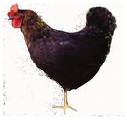 I
receive a lot of calls from people requesting help with an animal
family member being placed or moving to a new home or adjusting
to their new family. These calls usually involve things like
behavioral changes, eating changes, potty habit changes, along
with a much longer list of "issues". People don't understand
why these problems exist. After all, the humans know what's going
on and why things are happening and what they expect in the future.
Even people who deeply love their animal kids have these same
kinds of issues. They forget that animals need to also understand
what's happening to them and - most importantly - why. So they
either don't think to or forget to talk with the animals about
what is taking place. There are people who love their animals
very much and know about communication and assume the animals
will know what the humans know. People assume that everything
is OK and treat the animals like they know what's happening in
these types of situations. Very often, the animals don't understand
what they should. They understand something very different from
what is actually happening. I love to ask people how they would
feel in a similar situation where they are the one who didn't
know what's going on and had to either guess or try to figure
out what someone else was thinking. I have yet to find anyone
who would be alright not having information about what's changing
in their world. Animals are the same way. They need to be talked
to just like they are smaller human counterparts of the family
and have things explained to them in ways they understand. It
makes them feel safer, more valued. It really doesn't matter
if the change is from a move, a death in the family, or any other
reason. They may also need more time to "come around"
to the change. There may be a need to grieve, have remorse, or
any other emotion that a human might have in a similar situation.
They may not want the change, agree with it or want to cooperate.
These are all emotions they should be allowed just a much as
you would want to be allowed the emotions you were feeling. I
receive a lot of calls from people requesting help with an animal
family member being placed or moving to a new home or adjusting
to their new family. These calls usually involve things like
behavioral changes, eating changes, potty habit changes, along
with a much longer list of "issues". People don't understand
why these problems exist. After all, the humans know what's going
on and why things are happening and what they expect in the future.
Even people who deeply love their animal kids have these same
kinds of issues. They forget that animals need to also understand
what's happening to them and - most importantly - why. So they
either don't think to or forget to talk with the animals about
what is taking place. There are people who love their animals
very much and know about communication and assume the animals
will know what the humans know. People assume that everything
is OK and treat the animals like they know what's happening in
these types of situations. Very often, the animals don't understand
what they should. They understand something very different from
what is actually happening. I love to ask people how they would
feel in a similar situation where they are the one who didn't
know what's going on and had to either guess or try to figure
out what someone else was thinking. I have yet to find anyone
who would be alright not having information about what's changing
in their world. Animals are the same way. They need to be talked
to just like they are smaller human counterparts of the family
and have things explained to them in ways they understand. It
makes them feel safer, more valued. It really doesn't matter
if the change is from a move, a death in the family, or any other
reason. They may also need more time to "come around"
to the change. There may be a need to grieve, have remorse, or
any other emotion that a human might have in a similar situation.
They may not want the change, agree with it or want to cooperate.
These are all emotions they should be allowed just a much as
you would want to be allowed the emotions you were feeling.
Here is a wonderful example of how to be the most loving you
can be to an animal - even if it is not technically "yours".
As you might know, among other things, I do a radio show called
Talk With Your Animals During my last few shows a caller was
very concerned about a chicken who was essentially wild. Many
people would not assign a chicken to the same category as a dog
or cat. Luckily, this gentleman did. This chicken was important
to this man even though the chicken was not "his" and
was living on a neighboring property. The woman who used to live
in that house moved. While she had been there, she fed and cared
for the chicken. After she moved, the other people in the neighborhood
fed and looked out for the chicken. The current owner of the
property was not pleased with the chicken being there or people
feeding her on his property and had decided it had to stop. As
the neighborhood they lived in changed, it was no longer a safe
place for the chicken. Instead of discounting the chicken, the
man called the show to ask for help. His goal was to find the
best possible place for the chicken. He wanted me to ask what
she wanted and if she understood what and why her life was in
turmoil. He expressed to her how important her welfare was to
him and requested her help in relocating her if that was what
she wanted. After a period of time seeing what her life would
be like should she stay where she was, she agreed to consider
possibly moving. This was quite a feat for this particular chicken
as she was used to roaming free and not really having human contact,
let alone being put into a crate and transported. She did not
want to be caged and did not want to be killed and said she had
to have the information about what, when, where, etc the new
place would be like for her before she would agree to cooperate.
The man got all the information she needed and we set up a game
plan for her to be placed in a crate and driven to a wonderful
place called Pigs
for Peace Sanctuary where she would be fed, cared for and
allowed to roam free including flying (some places require birds
to have their wing feathers clipped so they can't fly). She agreed.
On the day of the transportation, instead of having to be caught,
she actually walked right into the cage. (What a wonderful display
of mutual trust and understanding.) She knew what needed to be
done and was willing to do it because she understood.
After the move was accomplished, this gentleman called back to
let everyone know that she was now at the sanctuary and to find
out how the chicken felt about her new home. Even though it had
been only a few days, she felt like she was going to enjoy her
new digs after she got used to them. The chicken was very proud
of herself because of how she handled the situation and was very
impressed with this gentleman because of the way he cared for
her. This caller continued to warm my heart because he was concerned
about the fact that there were other chickens at the sanctuary
with the same name. He wanted to know if she would like a new
name and, if so, what she might like to be called. She was not
sure because she had that name all her life. Her last request
for now was that he and her lady friend come visit - which, of
course, he plans to do.
This is a wonderful example of a person opening their heart to
an animal even if it is "just a chicken". The man was
willing to wait as the chicken decided she would stay where she
was and continued to talk with her about changes and how they
would affect her without trying to force any particular decision
on the chicken. Then, when she realized she could no longer stay
where she was, the man got all the information she needed so
she could cooperate with the relocation. This is a wonderful
example of each Being treating the other like equals. It's a
much kinder and, in my personal opinion, a much better way to
relate. This type of interaction takes all the guess work out
of changing situations for the animals and they can move forward
in more peace of mind, feeling more involved, more loved, which
usually means there are not the unwanted behaviors which are
more common when people think of their animals as possessions
or forget to let them know exactly what's going on.
As you might imagine, living with someone who treated you like
a possession is not a happy place to be for any human or animal.
One of the really wonderful things about animals is they can
teach us to open our hearts. They give us a safe place to learn
what unconditional love is all about. As we grow and understand,
we can then in turn appreciate and love more fully all our family
members. Learning to communicate with animals like you would
want to be communicated with is a marvelous way to learn to communicate
with all living things the way you would want to be communicated
with. There is no hierarchy in love. It does not matter whether
you are a child, a parent, grandparent or an animal, love species
dependent. It says, "Here is the situation. What do you
want to do about it?" And moves from the mutual response.
Please keep in mind that even though I am a professional in my
field of talking with animals, you, too, can talk with
your animals using pictures, words and feelings and speaking
more slowly. Use simple words and be sure to pause often so your
animal companion can integrate what you say. You'll love the
experience and so will your companion.
Until next time, I'm Joy reminding you, you can never love your
animal companions too much. You can only love them, hopefully,
enough.
If you would like to
schedule a private session with Joy, call 425-867-1779 or go
through www.TalkWithYourAnimals.com.
If you are interested in being a caller on Talk with your Animals,
please email Martha@AnimalRadio.com
to make arrangements. Joy Turner is a regular Animal Radio®
correspondent. She can be heard daily on Animal Radio Network.
LISTEN TO ANIMAL RADIO NETWORK NOW
 Email
your events to: root@AnimalRadio.com Email
your events to: root@AnimalRadio.com
16th Annual Walk With the Animals
Saturday, March 22, 2008
8am to 12 noon
Fairmont Park
Riverside, CA
 Riverside
Humane Society Pet Adoption Center presents its 16th Annual
Walk With The Animals fundraiser ,with Mayor Ron Loveridge as
Grand Marshal. Riverside
Humane Society Pet Adoption Center presents its 16th Annual
Walk With The Animals fundraiser ,with Mayor Ron Loveridge as
Grand Marshal.
Classic rock station KOLA 99.9
FM to broadcast from the event. Riverside (CA) Humane Society
Pet Adoption Center (RHSPAC) presents its 16th Annual Walk With
The Animals March 22 from 8 am to noon at Fairmount Park in Riverside.
Grand Marshal for the two-mile walk is Riverside Mayor Ron Loveridge
with his adopted dog Sundance. Proceeds will help provide care
and shelter for the cats and dogs awaiting adoption at RHSPAC.
Registration for walkers and
their pets starts at 8:00; walk begins at 9:00. Walk With The
Animals is free and open to the public. Participation in the
walk is not required. There will be food, entertainment, animal-related
exhibits, and activities for all ages. Classic rock station KOLA-FM
99.9 with Patti Banner will broadcast live from the event. Walk
participants are encouraged to collect pledges to sponsor their
effort.
| Rover, Get Off Her Leg! with
Darlene Arden |
 ASK
"THE DOG EXPERT"
- by Darlene Arden, Certified Animal Behavior Consultant ASK
"THE DOG EXPERT"
- by Darlene Arden, Certified Animal Behavior Consultant
Q. Dear Darlene Arden,
Is it true that being overweight is as bad for our dogs as it
is for us?
- Lizzie
A. Dear Lizzie,
 It
certainly is! Overweight dogs are subject to the same health
problems as their owners. This would include increased risk of
cancer, diabetes, cardiac problems, asthma, and collapsing trachea
(which is always a risk in small dogs, with or without the weight
problem). It
certainly is! Overweight dogs are subject to the same health
problems as their owners. This would include increased risk of
cancer, diabetes, cardiac problems, asthma, and collapsing trachea
(which is always a risk in small dogs, with or without the weight
problem).
Like us, dogs need proper diet and exercise. To tell if your
dog is overweight, look down at him and see if you can see an
indentation, or "waistline." If you can't, then it's
likely that your dog is overweight. The best person to help you
make this determination is your veterinarian. Your veterinarian
can also help you put your dog on a proper diet. And remember
that all training treats must be figured into the amount of food
your dog consumes each day.
If your dog isn't used to exercising, start with slow walks around
the block and gradually increase the amount of walking. You can
also get involved in dog sports like Freestyle, Rally-O, Agility
and Frisbee to mention a few of your choices. Remember to do
warm-ups and cool-downs just as you would for yourself before
and after exercising.
Dog sports are fun for you and your dog, will give you the opportunity
to make new friends, bond even more closely with your dog, and
help your dog stay in good condition as long as you are careful
of the type of moves he's making to be sure he isn't accidentally
injured.
"Ask the Dog Expert"
is a regular column by Darlene Arden. This month's column features
information found in her book, "The Angell Memorial Animal
Hospital Book of Wellness and Preventive Care for Dogs,"
(McGraw-Hill), which helps you, in concert with your veterinarian,
design a wellness program based on your dog, your lifestyle and
the place where you live, and "Small Dogs, Big Hearts,"
(Howell Book House), and the newly released, "Rover, Get
Off Her Leg!" Further information may also be found on her
website: www.darlenearden.com.
Copyright 2008 by Darlene Arden. All Rights Reserved.
| ANIMAL
RADIO® BOOK REVIEW for March |
|
    \(rated
4 out of 5 paws) \(rated
4 out of 5 paws)
 The
Dangerous Book for Dogs The
Dangerous Book for Dogs
By: Joe Garden, Janet Ginsburg,
Chris Pauls, Anita Serwacki and Scott Sherman
Hardcover: 208 pages
Publisher: Villard (October, 2007)
ISBN- 10: 0345503708
ISBN-13: 978-0345503701
You mainly see animal books
listed as "a book your animal wants you to read." However,
this book should be listed as "a book you don't want your
dog to read!"
Written (with help) by dogs
for dogs this book contains everything you try and teach your
dog not to do from chewing on your best shoes to making toys
out of household items.
For everyone who has loved
a dog, you will probably find similar situations that you have
gone through with your puppy. But I warn you - don't let this
book get into the "paws" of your four-legged friend
as this truly is a "dangerous book for dogs!".
    \(rated 3 and 1/2 out of 5 paws) \(rated 3 and 1/2 out of 5 paws)
 Paws &
Effect: The Healing Power of Dogs
by Sharon Sakson Paws &
Effect: The Healing Power of Dogs
by Sharon Sakson
Hardcover: 231 pages
Publisher: Alyson Books (December 2007)
ISBN-10: 1593500386
ISBN-13: 978-1593500382
It has been long known that
dogs are our faithful companions, but now it has been proven
that they are also our healers.
In Paws & Effect you will
find stories about dogs that can detect certain types of cancer
such as ovarian; dogs that can predict seizures; and dogs that
can even relieve the pain of arthritis.
You will find documentation
from academic institutions,, veterinarian offices, charitable
organizations and even the military to back up threes stories.
After reading Paws & Effect
hopefully you will communicate more effectively with your animals
and listen more closely when they speak.
See other reviews at AnimalRadio.com.
Send books and literature for review on-air and in this newsletter
to: Animal Radio Network™ Book Reviews, 233 East 330 North,
Kanab, Utah 84741. Product may not be returned. Allow 5 weeks
for review.
|
Questions
to Ask Yourself Before Adopting a Pet
 Having
a pet is so rewarding. It also requires some work and effort
on your part. Pets911.com wants to help you find the right pet
for you and your family. If you are considering getting a pet,
first of all, please adopt. Secondly, take a second to answer
the questions below before you begin your search. It will help
you and the adoption counselor help choose the perfect companion
for you! Having
a pet is so rewarding. It also requires some work and effort
on your part. Pets911.com wants to help you find the right pet
for you and your family. If you are considering getting a pet,
first of all, please adopt. Secondly, take a second to answer
the questions below before you begin your search. It will help
you and the adoption counselor help choose the perfect companion
for you!
1) Do you have time for a pet? Do you have a busy lifestyle?
Do you have a great many responsibilities and commitments? Do
you spend a lot of time at home or are you frequently away? As
with people, pets need daily love and attention. It can be time
consuming to devote this daily attention of keeping a pet clean,
well fed, healthy and providing daily exercise. You will also
want to spend some time training your pet and socializing him.
2) Have you considered the other pets in your home? Will they
need to adjust or will they get along with your new pet?
3) Do you want a calm, low-keyed pet or an active one?
 4) Are you permitted to and do
you have room for a new pet? Do you transfer and move a great
deal? Could you be moving on short notice? Do you think you would
be able to look in advance to find a place that allows pets? Is there a
deposit? Can you afford the deposit? Will the landlord increase
your rent for each pet you have? Is there a size and/or weight
requirement? Does the landlord allow only a certain number and
kind of pet? What will you do if you get caught with a pet if
it is not allowed? Don't forget, cats love to sun themselves
in windows and dogs bark at least once in a while. All pets,
no matter how small, need a place to sleep and room to roam around
the house. Inside cats need to have an area for their litter
box, while dogs should have fenced yards in which they can play
safely. 4) Are you permitted to and do
you have room for a new pet? Do you transfer and move a great
deal? Could you be moving on short notice? Do you think you would
be able to look in advance to find a place that allows pets? Is there a
deposit? Can you afford the deposit? Will the landlord increase
your rent for each pet you have? Is there a size and/or weight
requirement? Does the landlord allow only a certain number and
kind of pet? What will you do if you get caught with a pet if
it is not allowed? Don't forget, cats love to sun themselves
in windows and dogs bark at least once in a while. All pets,
no matter how small, need a place to sleep and room to roam around
the house. Inside cats need to have an area for their litter
box, while dogs should have fenced yards in which they can play
safely.
5) Can you afford a pet? There are basic expenses that go along
with pet guardianship that must be considered. Grooming, pet
food, general pet care supplies, as well as annual inoculations
and license
fees can add up. It can be considerably more costly if your pet
has an unexpected injury or illness. If you travel, there will
be boarding costs or transportation fees if your pet travels
with you. It would be unfair not to be realistic when budgeting
for your new pet, to ensure you are able to sufficiently and
comfortably provide for it.
6) Do you or does anyone in your family suffer from allergies?
Would that person be willing to take allergy shots? (Spend a
substantial amount of time with the animal in a small, confined
area to verify that allergies will not be a problem, if you are
not sure. Always put the safety of your family member first!)
7) Do you have patience? No matter how well trained and behave
a pet is, there will be times when accidents occur. Nobody's
perfect! When a pet is brought into a new home, it
needs time to adjust, it can take up to several months for your
pet to become totally comfortable in its new environment. When
animals are ill, just like humans, they need an extra dose of
tender loving care. Can you be patient, forgiving and loving?
**Keep in mind that while you have several options as to where
to buy or adopt a pet, your local animal shelters are a great place to
start. The variety of pets will assure that you find your perfect
companion. Plus, you'll be saving a new best friend that really
needs you.
Pets 911 Will continue this
article next month with "What to do When Your Bring Your
Pet Home."
Animal
Radio® is
a proud partner with Pets911!
Hear about the latest Pets911 activities on-air on Animal Radio®
G'day from down under!
 Last
month we mentioned our trip to the states. We went to LA, Ventura,
Las Vegas (in fact we stayed at the Monte Carlo that had that
fire there last month) San Diego, Boston and New York. Last
month we mentioned our trip to the states. We went to LA, Ventura,
Las Vegas (in fact we stayed at the Monte Carlo that had that
fire there last month) San Diego, Boston and New York.
Everywhere we went we saw nice
pets with very nice and very helpful people from all walks of
life and no-one made fun of our accents (you guys have accents
too ok!!)
But it was New York pet owners
that made us sit up and take notice. We stayed in Greenwich Village
in an apartment opposite NYU. Every day in the elevator, dogs
and their owners would come and go.
No fuss no yanking on
leashes to control jumping dogs. Often there would be two or
three at a time. No worries.
This city full of apartment
dogs and with only one minor exception (accidents happen!), we
saw no evidence of forgetful owners picking up after their dogs.
Even in the local parks where dogs go two, three or more times
a day to 'empty' as we call it, there was no visible evidence
of them having been there.
Was it the fact it was winter
get out and back inside as fast as possible? Maybe, but
it showed us albeit from a spectators point of view, that
New York dogs are probably the most socialised of all dogs anywhere.
Here in Australia it's getting
harder and harder to have dogs and cats or any pet for that matter
whether it be in apartments or free standing homes with
backyards on a single block.
The reason? officially
because of 'health and safety reasons' Some councils actually
limit the number of pets to just one or two after that
you need a special licence.
So why is this happening?...
There are many reasons including some animal activist groups
who don't want anyone to 'own' a pet.
But we think some Aussies themselves
might be partly to blame.
A lot of Aussie pet owners
simply leave their pets mostly dogs in the backyard
and these dogs rarely get out to socialise with other dogs or
people or get exposed to kids on bikes or traffic etc.
And when they do get out they
become a nuisance... jumping, barking and behaving badly or even
escaping and running wild so it's easier to ban something
than to try and find ways of fixing it.
Even though we didn't get to
interview any New Yorkers about their pets, we spoke with several
of them and certainly have a good overall picture what life is
like for apartment pets. And we'll be telling our listeners what
we think the secret is.
Socialise socialise socialise
your pets from as early an age as possible. Dogs especially who
are used to all kinds of people, other animals, cars, bikes and
young children especially, are bound to grow up 'sensibly', providing
they have 'sensible' owners too.
Ask any postman or pizza delivery
guy what it's like to be bailed up by a snarling snapping schnauzer
or rottweiller!
If you have a story about socialising
your pet we'd love to share it with our Aussie listeners
we can all learn from each other and we know they'd like to hear
from you too. Just email producers@pettalkradio.com or get in touch
with Hal & Judy from Animal Radio.
Hugs for your pets from Brian
& Kaye!
Hear Pet Talk Radio! on
Animal Radio Network - LISTEN TO ANIMAL RADIO NETWORK NOW
- Check schedule for showtimes.
Voice of the Animal on Animal Radio®
Rae Ann Kumelos Ph.D. |
ONCE UPON OUR TIME: The
Fairy Tale Animal Helper
 Before time. Beyond time. Once
upon a time. When we read these words, we know we are in the
realm of enchantment. Narratives that begin this way are fairy
tales. Fairy tales are timeless and placeless; they evoke a realm
where anything is imaginable and probable. There is a pause in
eternity, a spaciousness of time to a fairy tale that allows
for suspension of disbelief about what is or is not possible.
In the world of fairy tale, animals talk with people to inspire,
guide, assist, and protect. Might this have actually happened?
And, if so, is this still possible today? Before time. Beyond time. Once
upon a time. When we read these words, we know we are in the
realm of enchantment. Narratives that begin this way are fairy
tales. Fairy tales are timeless and placeless; they evoke a realm
where anything is imaginable and probable. There is a pause in
eternity, a spaciousness of time to a fairy tale that allows
for suspension of disbelief about what is or is not possible.
In the world of fairy tale, animals talk with people to inspire,
guide, assist, and protect. Might this have actually happened?
And, if so, is this still possible today?
One way to interpret the fairy tale animal is as an image that
conveys archetypal patterns-universal images and blueprints--that
serve as reflections of our own inner nature. Marie Louise von
Franz, the famous student of psychologist Carl Jung, discovered
a remarkable fact about the role of the animal in fairy tales.
In the many hundreds of stories she studied over the years, always
on the lookout for some basic overall guidelines that could be
applied to human behavior, she found only one rule for which
there is no exception or contradiction: "if you do not listen
to the helpful animal or bird, whatever it is, if any animal
gives you advice and you don't follow it, then you are finished."
Finished! It did not matter what the animal told the hero to
do: lie, don't lie, fight, don't fight. What mattered was following
the animal's advice. Not to do so invited certain disaster.
As psychologists, both von Franz and Jung interpreted this remarkable
finding of the role of the animal in fairy tale as embodiment
of our own animal instincts. We see examples of comparing instinctual
animal behavior to our own in our everyday colloquialisms: "clever
as a fox;" "the eyes of a hawk;" and "horse-sense."
These instinctual and psychological perspectives hold value;
they give us a language of analogy that is implicitly understood
in our culture. Yet, they do seem to privilege human beings over
our animal companions. What about the actual physical presence
of a fox, hawk, or horse? Is their appearance or companionship
in our lives reduced only to observing their instinctual characteristics
for guidance in our actions? Does that mean that if I happen
to see a fox in my backyard, I am to assume she is telling me
to be clever and cunning in whatever I happen to be doing? Is
this what the role of the animal helper in fairy tale meant?
That is one possibility. Another idea comes from the world of
the shaman. The mythologist Joseph Campbell called the shaman
a "walker of worlds between ordinary and non-ordinary reality."
Shamans see the universe and all of the creatures in it as part
of an interconnected web of life, or whole, based upon their
own experiences within that web of life. A shaman's spirit journey
into another realm allows him or her to directly experience the
web of life and a mystical unity with all of nature. It is while
in this intentional trance state that the shaman meets up with
his animal spirit guide, in fairy-tale language, an animal helper,
who in turn guides him/her in some area that will elevate and
inspire his soul, and through him, enriches his community. In
the fairy-tale world, this guidance and inspiration eventually
culminates in a 'happily-ever-after' ending.
We see this shamanic 'walking between two worlds' motif in tales
when the hero is out in a forest and suddenly finds himself in
a timeless Otherworld, usually inhabited with talking animals
that help him in his quest. (In Celtic tales, if these animals
are white with red ears, then one knows they are in the land
of faerie). In the Cinderella fairy tale, which is a story found
in cultures all over the world, we see Cinderella traveling back
and forth between the otherworldly realm of the magical ball
and her mundane life in the cinder-ashes. In the Disney movie
of this timeless tale, the version we in America are most familiar
with, rats and lizards are transformed into horsemen and footmen
who ferry Cinderella back and forth between the two worlds. In
the Irish version, Cinderella is assisted by a tortoise-shell
cat who gives her all she needs. The Egyptian Cinderella's wishes
are granted from a tree that grows on the grave of her pet animal.
In all these versions, she is helped by her animal friends. Might
Cinderella be a shamaness, dancing between the realms in slippers
of rainbowed glass, her various animal helpers partners on her
enchanted dance card? We all know what it is like when we are
engaged in an activity we love and lose all sense of time; it
is magical. At that place and space, are we perhaps walking in
the Otherworld of fairy tale? Might we be able, like Cinderella,
to enjoy an enchanted Otherworldly state where we too can ask
our animal friends for wisdom and guidance?
Maybe so. I do like the idea because Cinderella's Otherworld
brings us a little closer to appreciating the animals that live
with us in this world. Here is one more lens through which to
view the fairy tale animal helper: dreams. Scholars speculate
that fairy tales may have come from nighttime dreams in which
a person was helped by an animal; the next morning over the day's
chores, trips to the local well, or in gatherings with the royal
court, the dream was then recounted, perhaps as fact, and a fairy
tale was born. Today, in modern-day dream work when the focus
is on the animal dreams of the individual, it is not just for
the instinctual 'horse-sense' reasoning the animal brings, but
to hear the actual voice of the animal in the dream. Just what
is it that polar bear, tiger, lizard, dolphin, or ladybug is
trying to tell you? In a harried and hurried society where we
often do not take the time to pay attention to the natural world,
whether it is the presence of our own cats and dogs, or the appearance
of the fox in the backyard, our dreams can act as a radio through
which other voices are broadcast. It is one place where we let
go of the craziness of a busy day long enough for us to hear
the wisdom and guidance of the animals. And, the animals need
us to hear them, for their message and wisdom lies mute until
the dream is engaged. And from that engagement-something we can
actually do through journals, meditation, active imagination,
even discussion over our modern-day wells and royal courts, the
office water cooler--will emerge stories and images of divine
guidance and inspiration in a fairy tale narrative to carry us
back and forth between the otherworld of dream and into our waking
lives.
Whether we choose to believe that the animal helpers of fairy
tale are purely instinctual parts of the psyche, that they actually
exist in the timeless realm of the Otherworld, or that they speak
to us through our nighttime dreams, one fact remains consistent:
their message is essential to our individual and collective well-being.
Once upon our time, we can choose to follow in the dance steps
of our fairy tale heroes and heroines. We too can choose to engage
and embrace the four-footed, crawling, swimming, and winged helpers
that consistently envelop and protect us in a timeless weave
of inspired grace. And that is no fairy tale.
Visit us at http://www.voiceoftheanimal.com to hear more
stories and to order CD's of Voice of the Animal programs. Copyright
2008 Voice of the Animal. Rae Ann Kumelos is a regular
Animal Radio® correspondent. She can be heard daily on Animal
Radio Network. LISTEN TO ANIMAL RADIO NETWORK NOW
| Ask the Bird Folks with
Mike O'Connor |
 Dear
Bird Folks, Dear
Bird Folks,
Here is a question that I'll bet you've never been asked before.
Mockingbirds are great at mimicking the calls of other birds,
but what does their real voice sound like? Do they actually have
their own voice or are all of their vocalizations a copy of some
other bird?
- Melissa, Avon, MA
Don't bet, Melissa,
I wouldn't bet that I haven't
been asked this question before. Last year a third grade school
teacher asked me the same question. The question was put to her
by one of her students and she came to me looking for the answer.
Unfortunately, the teacher couldn't remember the student's name,
so I wasn't able to use it in a column until now, thanks to you.
You get credit for asking the question, but it's not a new one;
therefore, you would have lost the bet. And believe me, after
this last Super Bowl, I know all about losing bets. Grrr.
Even though this bird is typically
found south of Canada, it is still called a Northern Mockingbird.
The reason for the "northern" part of the name is that
there are several species of mockingbirds living in the Americas,
with the bulk of them living further south of the Northern Mockingbirds'
range. One species, the Chalk-browed Mockingbird, which looks
as dull as it sounds, can be found as far south as Argentina.
In fact, most mockers are fairly dull-looking. But beauty isn't
what these birds are all about. With their vast array of vocal
skills mockers don't need to waste their time on growing fancy-colored
feathers. They leave the colorful stuff for the tone-deaf birds.
 Like
Rich Little of the last century, or perhaps Frank Caliendo of
this one, mockingbirds are masters at imitating the voices of
others. Some mockers have been known to incorporate several hundred
different calls into their songs. Most of these calls are borrowed
from other birds, but they also may imitate the sounds of barking
dogs, chirping insects or squeaky doors. And we are not talking
cheesy Vegas imitations here. Mockingbirds, with their little
bird brains, are able to formulate superb imitations that are
dead-on like the original. Mockers are quite often able to fool
experienced bird watchers, who, in theory, have much larger brains.
More than one birder has gone running off to see a particular
bird only to come back mumbling something about a %#$%!#?! mockingbird.
Even sonagrams produced by sophisticated machines can't tell
which is the original and which is the impostor. Yet, mockingbirds
are rarely good enough to fool the real owners of the call, which
is a good thing. The last thing a male mockingbird wants is to
attract every available female wren, blackbird, or cardinal and
have to explain that he likes them, but he only wants to be friends. Like
Rich Little of the last century, or perhaps Frank Caliendo of
this one, mockingbirds are masters at imitating the voices of
others. Some mockers have been known to incorporate several hundred
different calls into their songs. Most of these calls are borrowed
from other birds, but they also may imitate the sounds of barking
dogs, chirping insects or squeaky doors. And we are not talking
cheesy Vegas imitations here. Mockingbirds, with their little
bird brains, are able to formulate superb imitations that are
dead-on like the original. Mockers are quite often able to fool
experienced bird watchers, who, in theory, have much larger brains.
More than one birder has gone running off to see a particular
bird only to come back mumbling something about a %#$%!#?! mockingbird.
Even sonagrams produced by sophisticated machines can't tell
which is the original and which is the impostor. Yet, mockingbirds
are rarely good enough to fool the real owners of the call, which
is a good thing. The last thing a male mockingbird wants is to
attract every available female wren, blackbird, or cardinal and
have to explain that he likes them, but he only wants to be friends.
Even with all of their vast
ability to learn many different songs, calls and sounds, mockingbirds
have their limits. They don't seem to be able to master complicated
birdsongs and they may only learn simple snippets from long songs.
I think mockingbirds are a lot like us in this ability. Most
of us can sing short parts of many songs but, with the exception
perhaps of Happy Birthday to You and One Hundred Bottles of Beer
on the Wall, most us can't sing an entire song. However, unlike
us, mockingbirds don't sing for pleasure or to help pass the
time on a long bus ride. They sing to impress the ladies. A male
mockingbird that sings the loudest, the longest and with the
greatest variety of sounds has the best chance of attracting
a mate. And let's face it, mate attraction is much more important
than passing time on a long bus ride.
The vast assortment of songs
that mockers use to attract a mate are made up in part, if not
entirely, of songs lifted from other sources. But in addition
to their songs, mockingbirds also have an assortment of call
notes, which are different from songs. Call notes are used to
communicate information. Mockingbirds have series of raspy "chur"
and "chuck" sounds that they use to warn of danger
or to alert their chicks when they bring them food. They also
have aggressive scolding sounds that they use when driving out
predators or chasing away other mockingbirds that have intruded
into their territory. These nonmusical sounds are probably the
real voice of the mockingbird. They are specific to them and
aren't stolen from some other bird species. I guess if all you
can say with your real voice is "chur" and "chuck,"
it's a good reason to imitate others. Hmm, I wonder if Rich Little
has the same problem.
What a mockingbird's real voice
sounds like is a very good question, Melissa, and you shouldn't
feel that it isn't just because a third grade kid has already
asked it. Third graders are much more advanced than when I was
in school. We never studied about birds back then. The only thing
I remember learning in third grade was how to hold scissors,
how to tie my shoes and, of course, the words to One Hundred
Bottles of Beer on the Wall. I definitely don't think I was in
the advanced class.
Besides being a frequent
guest on Animal Radio®
- Mike O'Connor is the
owner of the Bird Watcher's General Store on Cape Cod, which
opened in 1983 as one of the first stores in the United States
dedicated solely to birding. His column, Ask the Bird Folks,
appears weekly in The Cape Codder, The Register, The Harwich
Oracle, and The Upper Cape Codder newspapers, and his writing
was included in the Best American Science and Nature Writing
2004. Copyright 2007 by Mike O'Connor. All Rights Reserved. http://www.BirdWatchersGeneralStore.com
| Reader and Listener Comments: |
EMAIL US: YourVoice@AnimalRadio.com
To Whom It May Concern:
I felt a bit nauseated after reading the comparison of Hillary
to a Pit Bull (Animal Radio® February Newsletter). I
am not a supported of Mrs. Clinton however I do support Pit Bulls,
the most maligned breed on the face of this earth. I have raised
3 children with American Pit Bull Terriers and am helping raise
my little grandson with one. Pit Bulls were very popular pets
in the 1800's and early 1900's. Times have changed but they remain
stable, loyal, loving and to this day score very high on temperament
test. According to The American Temperament Test Society pit
bulls consistently rate higher every year than many common "family"
dogs, including the Golden Retriever and Greyhound. You can go
to www.atts.org
and see the test results of all breeds.
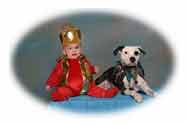 I
have attached a picture of Roxie, my Pit Bull and my grandson
dressed in their Halloween costumes. As you can see my dog is
a huge part of our family, she is 5 years old and NEVER attacked
anybody or anything. She sleeps with two cats every night. Unlike
the myth propagated by the mass media, human aggression is NOT
a problem specific to the breed and they are NOT attack dogs! I
have attached a picture of Roxie, my Pit Bull and my grandson
dressed in their Halloween costumes. As you can see my dog is
a huge part of our family, she is 5 years old and NEVER attacked
anybody or anything. She sleeps with two cats every night. Unlike
the myth propagated by the mass media, human aggression is NOT
a problem specific to the breed and they are NOT attack dogs!
While the idea behind the piece was fun, it was terribly written
and not well thought out. Most of all it was inaccurate, I was
not impressed and felt a bit insulted for Pit Bulls and their
owners everywhere.
Thank you,
Tammy Townsend
 Dear
Animal Radio: Dear
Animal Radio:
We thoroughly enjoyed this
month's newsletter article on the presidential candidates and
comparison to their respective breeds. And we especially enjoyed
the Russian Dog Wizard's take on it. I'm sure you've seen this
week's latest pick to come from the Obama camp - appealing to
the pet-lovers nationwide. Thanks! Remy Florence
If you would like to tell Animal
Radio® how you keep the peace in bed, or have any other comments,
call toll-free 866-405-8405 or email YourVoice@AnimalRadio.com
|
|
Final Thoughts:
Who's
a "Copycat"? Where did that "coin of phrase"
come from?
 Certainly, not from any respectable
cat with dignity. Although it's been said, to copy or mimic is
the highest form of flattery, maybe the human species would do
well to copy or mimic others who seem to possess the art of living
to it's purrfection or at least to a degree of higher standards. Certainly, not from any respectable
cat with dignity. Although it's been said, to copy or mimic is
the highest form of flattery, maybe the human species would do
well to copy or mimic others who seem to possess the art of living
to it's purrfection or at least to a degree of higher standards.
You know....sniff around more.
Be fully aware of your environment and surroundings.
Take an eye- opening look at
nature. Watch the birds and squirrels. Study how they save and
horde for rainy days.
Exercise in ways you never
thought of. There's a lot to be said for jumping to catch butterflies
or running from bees and other flying insects.
I, myself have perfected this
small but dynamic form of getting in shape.
Every bee I encounter has me
running and jumping in place, or even out of the house till I
am breathless. So this action is good for the lungs as well.
My cats always inform me if a bee is in our territory, as I am
sure they get a big kick from watching "much to do about
nothing".
 S
T R E E E E E E E T C H...watch your cat. Get on your hands and
knees. Lower the front torso to the ground, point the rear upward
and S
T R E E E E E E E T C H...watch your cat. Get on your hands and
knees. Lower the front torso to the ground, point the rear upward
and
WOW! This takes all the kinks
from your back. You will have a feeling of wellbeing and contentment.
When feeling bored, stressed
or for no particular reason, just find the nearest, soft, place
to curl in a ball (this is why the above stretching exercise
is so important) and dose off for a bit or the whole rest of
the day or night.
After the rejuvenating nap,
it will be time for a nice meal to pick at. No need to gorge
your self, as there will be nibbling later. It's best to eat
less in more intervals throughout the day and night. This will
keep you svelt and able to leap tall furniture or shelving. Even
the top of the refrigerator will be attainable. Then you can
have the ability to view your territory.
Tips & Advice from "Secrets
of Cat Attitude Revealed" A Cat's Step-By-Step Living Advice
by Carolyn Bartz
Final Pic:
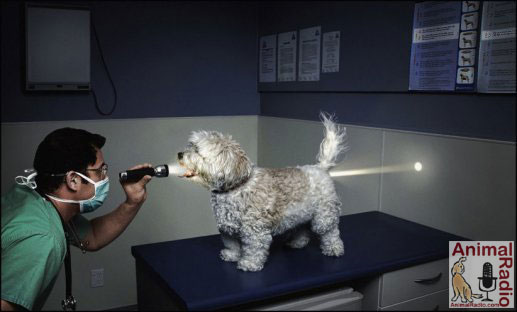
LISTEN TO ANIMAL RADIO NETWORK NOW
Return to Menu
Go to AnimalRadio.com
|
| Search Animal Radio®
Network |
|
|
|
|
 FINAL POOP FINAL POOP
* COPYRIGHTS:
Animal Radio® and
Animal Radio® Network
are Registered Trademarks of Animal Radio Network LLC, and may
not be used in affiliation without express written consent of
Animal Radio Network LLC. Material in this newsletter may not
be published or broadcast without permission. All rights reserved
- Fair Use Notice: The not-for-profit educational reproduction
of some articles contained within this newsletter constitutes
fair use of the copyrighted material as provided for in section
107 of the US Copyright Law.}
 * CONTRIBUTIONS, EDITORIALS OR SUBMISSIONS
to Animal Radio® Network
Newsletter or Programming may be sent to: 233 East 330 North,
Kanab, UT. 84741 or root@animalradio.com.
Unsolicited manuscripts may not be returned. See our website for additional information
about article submissions. Email your editorial comments or opinions
to us at: YourVoice@AnimalRadio.com * CONTRIBUTIONS, EDITORIALS OR SUBMISSIONS
to Animal Radio® Network
Newsletter or Programming may be sent to: 233 East 330 North,
Kanab, UT. 84741 or root@animalradio.com.
Unsolicited manuscripts may not be returned. See our website for additional information
about article submissions. Email your editorial comments or opinions
to us at: YourVoice@AnimalRadio.com
* If you're a RADIO PROGRAMMER
and would like to air ANIMAL RADIO®
- call 435-644-5992 to get all the information you need to begin
broadcasting America's number one animal talk show geared to
listeners that like to have FUN! Animal Radio® programming is FREE for your station
- and delivered via Satellite (Jones and ABC/NY Starguide) or
Compact Disc or MP3 every week.
 *
ADVERTISING OPPORTUNITIES for 2008 ANIMAL RADIO®
PROGRAMMING available. Call 435.644.5992. Animal Radio® Network, according to Arbitron radio
ratings, is the most-listened-to animal programming in the United
States. Animal Radio® airs
weekly in ninety-plus cities. Our affiliate stations are top
performers including KOST 103.5 in Los Angeles. Animal Radio® is the most concentrated radio audience
of targeted animal lovers anywhere! Please contact us for aggressive
and omnipotent branding and cultivating customer loyalty. Advertising
opportunities in this newsletter are also available. 40,000 subscribers
are reading this newsletter right now! *
ADVERTISING OPPORTUNITIES for 2008 ANIMAL RADIO®
PROGRAMMING available. Call 435.644.5992. Animal Radio® Network, according to Arbitron radio
ratings, is the most-listened-to animal programming in the United
States. Animal Radio® airs
weekly in ninety-plus cities. Our affiliate stations are top
performers including KOST 103.5 in Los Angeles. Animal Radio® is the most concentrated radio audience
of targeted animal lovers anywhere! Please contact us for aggressive
and omnipotent branding and cultivating customer loyalty. Advertising
opportunities in this newsletter are also available. 40,000 subscribers
are reading this newsletter right now!
* WEBMASTERS: Offer your
web-visitors Animal Radio®
audio content when they visit your website. Cut and paste the
code below to create a graphical link directly to the Animal
Radio®.
<A HREF="http://animalradio.com/cfc.mp3">
<IMG SRC="http://animalradio.com/listenowbutton.gif"
ALIGN="BOTTOM" BORDER="1" ALT="AnimalRadio.com"></A>
Offer your web-visitors
Pet Headline News:
Give your visitors up-to-the-minute
news headlines direct from Animal Radio® - Put this
Animal Radio® News Module on your website. Place the following code
where you want the module to show up. 
<p style="margin-top:10px;
margin-bottom:0; padding-bottom:0; text-align:center; line-height:0">
<a href="http://feeds.feedburner.com/~r/AnimalRadioNews/~6/1"
TARGET="_blank">
<img src="http://feeds.feedburner.com/AnimalRadioNews.1.gif"
alt="Animal Radio News" style="border:0"></a></p>
<p style="margin-top:5px; padding-top:0; font-size:x-small;
text-align:center">
* HOW TO UNSUBSCRIBE FROM
THIS NEWSLETTER (sorry to see you go!) To be Removed from
this list - Please reply
with "Unsubscribe" in the subject line. You will be
removed within 24 hours. NOTE: You must reply from the exact
same address that you used to sign up for this newsletter. WANT
TO SUBSCRIBE? Go to http://AnimalRadio.com
to sign up from the front page.
Copyright 2008
Animal Radio® Network LLC
|
|